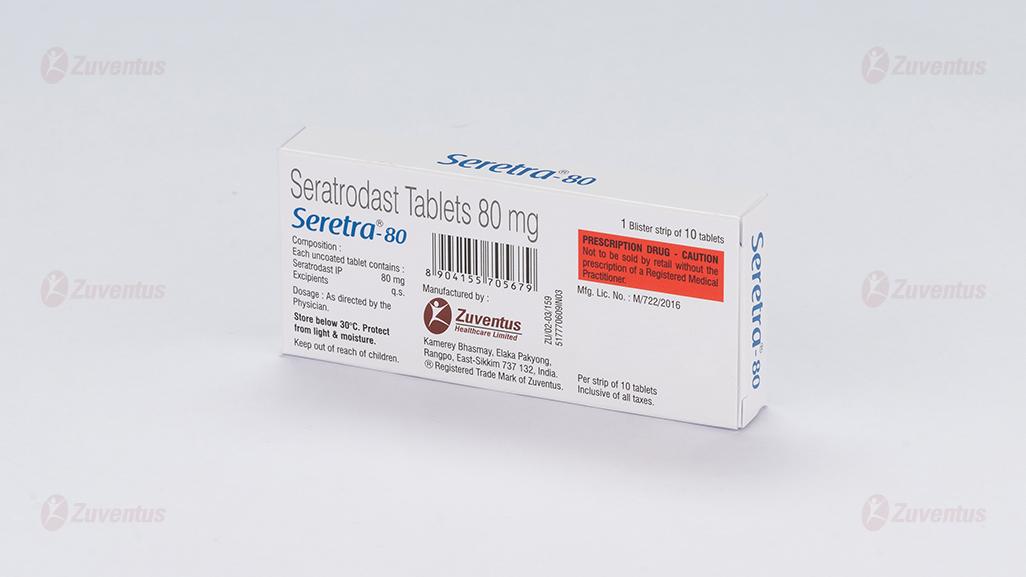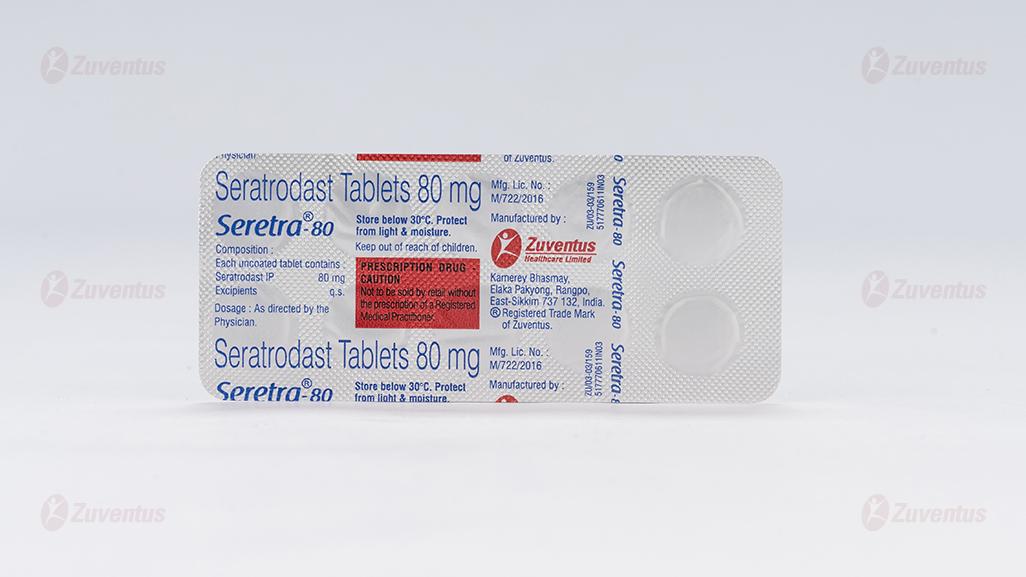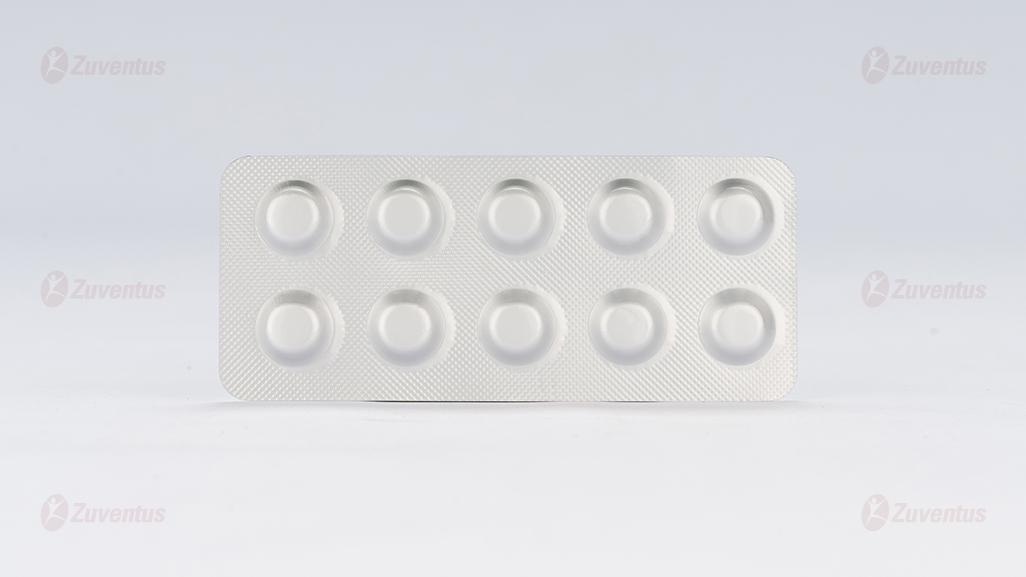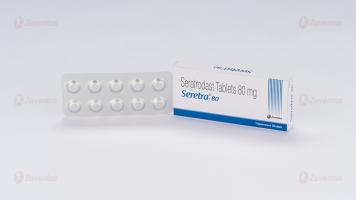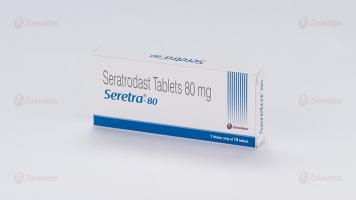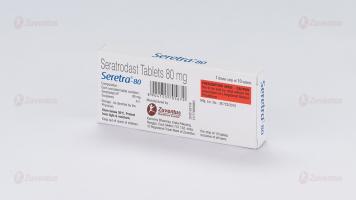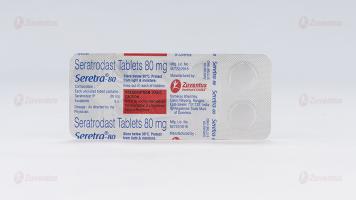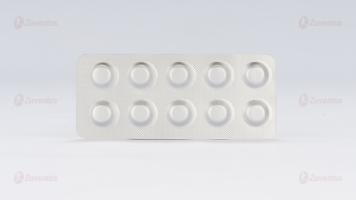Seretra Tablets
Therapy Area
Respiratory
1.0 Generic Name
Seratrodast uncoated tablet
2.0 Qualitative and quantitative composition
Each uncoated tablet contains: Seratrodast 80 mg
3.0 Dosage Form and Strength
Uncoated tablet 80 mg
4.0 Clinical particulars
4.1 Therapeutic indications
Seretra is indicated in prophylactic management of mild to moderate asthma.
4.2 Posology and method of administration
- Adults: The recommended dose of Seretra is 80 mg once daily. Seretra has been shown to be well-tolerated following repeated once daily oral doses of up to a maximum of 320 mg.
- In elderly patients, the treatment should be started with a lower dose of 40mg/day.
- Pediatric Use (< 18 years of age): The safety and efficacy of Seretra has not been established in children and should not be used in this age group.
4.3 Contraindications
- Hypersensitivity to Seretra or any of the ingredients.
- Patients with hepatic failure.
4.4 Special warnings and precautions for use
Seretra may lead to an elevation in the levels of the hepatic enzymes. Therefore, it has to be administered with caution in patients with hepatic impairment.
4.5 Interaction with other medicinal products and other forms of interaction
- Use cautiously with other anti-inflammatory analgesics, cephalosporin antibiotics and drugs that have been reported to cause hemolytic anemia.
- As aspirin can compete for serum protein binding, it may increase the concentration of unbound drug (seratrodast) by 26%.
4.6 Pregnancy and lactation
Pregnancy and Lactation: There are no adequate and well controlled studies in pregnant women. Seretra should be used during pregnancy only if the potential benefit justifies the potential risk to the fetus. Seretra should be avoided during lactation.
4.7 Effects on ability to drive and use machines
Seretra is not expected to affect a patient's ability to drive a car or operate machinery.
4.8 Undesirable effects
Adverse reactions are generally rare, but if present, range from mild to moderate in severity.

Reporting of suspected adverse reactions
Reporting suspected adverse reactions after authorisation of the medicinal product is important. It allows continued monitoring of the benefit/risk balance of the medicinal product. Healthcare professionals are asked to report any suspected adverse reactions via email to:medico@zuventus.com
Website: http://www.zuventus.co.in/safety.aspx
By reporting side effects, you can help provide more information on the safety of this medicine.
4.9 Overdose
There have been no reports of overdosage with Seretra. In cases of overdosage, the stomach should be emptied by aspiration and gastric lavage. Vital parameters should be managed symptomatically.
5.0 Pharmacological properties
5.1 Pharmacodynamic properties
Seratrodast is a potent, long-acting, stereospecific thromboxane A2/prostaglandin endoperoxide receptor antagonist. The R-(+)-enantiomer of Seratrodast is the pharmacologically active moiety. Seratrodast appears to exert its anti-inflammatory effects through antagonism of the thromboxane A2 receptor (TP receptor). In addition, seratrodast blocks the broncho-constrictor effect of PGF2α, PGD2 and 9α, 11β-PGF2 mediated through activation of TP receptor.
5.2 Pharmacokinetic properties
Following single and repeated oral administration, seratrodast is rapidly and dose- dependently absorbed. The peak plasma concentrations of seratrodast increase proportionally with dose reaching steady-state concentration within 7 days of administration. Following once daily doses of 80mg for 15 days in patients with mild to moderate asthma, the peak plasma concentration of Seratrodast is 8.80 µg/ml with an average Tmax of 2.4 hours. The area under the plasma concentration-time curve (AUC) for Seratrodast is 22.96 µg.hr/ml and the average apparent volume of distribution is 33 liters.
Seratrodast has high protein binding capacity (more than 99%). It is metabolized to 5- methylhydroxyseratrodast and 4-hydroxyseratrodast by cytochrome P450 (CYP) isoenzymes. It is also partially (35%) glucuronidated in plasma and may be subjected to enterohepatic recycling. Following oral administration of 40 to 120 mg/day in healthy subjects the renal clearance of seratrodast ranges from 5.10 to 8.94 ml/hr (average 7.0 ml/hr) after a single dose and at steady-state respectively. The percentage of the dose excreted as unchanged drug in the urine ranges from 0.42% to 1.37% (average 0.83%) after a single dose and at steady-state. The plasma concentrations decline bi-exponentially with an average half-life of 20 and 36 hours after single and multiple administrations, respectively.
6.0 Nonclinical Properties
6.1 Animal Toxicology or Pharmacology
Acute Toxicity
The acute toxicity of seratrodast was assessed in mice and rats via oral, subcutaneous, and intraperitoneal administration at doses from 625 to 5000 mg/kg/d. Mortality was linked to lung congestion, as shown by necropsy. Surviving animals exhibited various pathological changes: spleen enlargement in subcutaneously treated rats, liver enlargement and interlobular adhesion in intraperitoneally treated animals, and visceral organ adhesion with white coating on the spleen in some mice. The LD50 values for oral gavage ranged from 1620 mg/kg/d in male mice to about 5000 mg/kg/d in female rats.
Chronic Toxicity
Seratrodast was administered to rats at various doses for 13 weeks by oral gavage (0, 4, 20, 100, or 500 mg/kg/d) and for 52 weeks in the diet (0, 3, 10, 30, or 100 mg/kg/d). No deaths or significant changes in clinical signs, ophthalmoscopy, or urine composition were observed. At high doses (100 and 500 mg/kg/d), weight gain was reduced, and erythrocyte numbers, hemoglobin, and hematocrit values decreased. Additionally, increased kidney, liver, and spleen weights, along with histopathological changes such as increased hematopoiesis and hepatocyte hypertrophy, were noted. The study concluded that seratrodast is toxic at high doses, with a nontoxic dose level between 10-20 mg/kg/d.
Mutagenicity, Reproductivity, Teratogenicity and Antigenicity
The mutagenic potential of seratrodast was assessed using the micronucleus test in male mice and the reversion test in various bacterial strains, with results indicating that seratrodast was not mutagenic and was not metabolized into mutagenic substances. Additionally, at doses up to 100 mg/kg/d, seratrodast showed no adverse effects on fertility, reproductive performance, or F1 generation development in rats, nor did it cause teratogenic or lethal effects in rabbits. Furthermore, seratrodast was found to be non-antigenic in guinea pigs and mice, whether administered alone or as a conjugate with human serum albumin.
7.0 Description
Seratrodast is an orally active quinone derivative and a potent Thromboxane A2 (TXA2) receptor antagonist used in the prophylactic management of asthma.

Chemical name: (±) 7-phenyl-7-(2, 4, 5-trimethyl-3, 6-dioxocyclohexa-1, 4-dien-1-yl) heptanoic acid
Molecular formula: C22 H26 O4
Molecular weight : 354.44
8.0 Pharmaceutical particulars
8.1 Incompatibilities
Not applicable
8.2 Shelf-life
Refer on pack
8.3 Packaging information
1 Blister strip of 10 tablets
8.4 Storage and handing instructions
Store below 30°C. Protect from light & moisture. Keep out of reach of children.
9.0 Patient Counselling Information
- Inform your doctor if you are suffering from liver diseases as seratrodast treatment can lead to an elevation in the levels of liver enzymes.
- Tell your doctor if you are or planning to become pregnant. Seratrodast should be avoided during breastfeeding.
- Do not take any anti-inflammatory analgesics (painkiller), cephalosporin antibiotics and drugs that have been reported to cause hemolytic anemia, along with seratrodast.
12.0 Date of revision
03.09.2022
Please read this leaflet carefully before you start using this medicine because it contains important information for you.
- Keep this leaflet. You may need to read it again.
- If you have any further questions, ask your doctor or pharmacist.
- This medicine has been prescribed for you. Do not pass it on to others. It may harm them, even if their signs of illness are the same as yours.
- If you get any side effects, talk to your doctor or pharmacist. This includes any possible side effects not listed in this leaflet.
What is in this leaflet
1. What Seretra is and what it is used for
2. What you need to know before you use Seretra
3. How to use Seretra
4. Possible side effects
5. How to store Seretra
6. Contents of the pack and other information
1. What Seretra is and what it is used for
Seretra contains the active substance seratrodast. It is used for the prophylactic management of mild to moderate asthma.
2. What you need to know before you take Seretra
Do not take Seretra if:
- You are allergic to seratrodast or any of the other ingredients of this medicine.
- You have hepatic (liver) failure.
Warnings and precautions:
- Inform your doctor if you have liver disease, as Seretra can elevate liver enzyme levels.
- Avoid taking anti-inflammatory analgesics, cephalosporin antibiotics, and drugs that cause hemolytic anemia while on Seretra.
Other medicines and Seretra:
Yes, Seretra can interact with other medications. Here are some important interactions to be aware of:
- Anti-inflammatory analgesics: Use Seretra cautiously with other anti-inflammatory analgesics as they can increase the risk of adverse effects.
- Cephalosporin antibiotics: There is a potential interaction with cephalosporin antibiotics, which may increase the risk of hemolytic anemia.
- Drugs causing hemolytic anemia: Avoid using Seretra with drugs known to cause hemolytic anemia.
Pregnancy and breastfeeding:
- There are no adequate studies in pregnant women. Use Seretra during pregnancy only if the potential benefit justifies the potential risk to the fetus.
- Avoid using Seretra while breastfeeding.
Driving and using machines:
- Seretra is not expected to affect your ability to drive or use machines.
3. How to take Seretra
Always use Seretra exactly as your doctor has told you. You should check with your doctor or pharmacist if you are not sure.
Adults:
The recommended dose is 80 mg once daily. The maximum dose is 320 mg per day.
Elderly patients:
Start with a lower dose of 40 mg per day.
Children:
Seretra is not recommended for use in children under 18 years of age.
If you use more Seretra than you should
Tell your doctor if you accidentally use more than you were told.
If you forget to use Seretra
If you forget to take at the right time, use it as soon as you remember, then carry on as before. Do not take a double dose to make up for a forgotten dose.
If you stop using Seretra
Do not stop your treatment even if you feel better unless told to do so by your doctor. If you have any further questions on the use of this product, ask your doctor or pharmacist.
4. Possible side effects
Like all medicines, this medicine can cause side effects, although not everybody gets them.
Common side effects (may affect up to 1 in 10 people):
- Rash, itching
- Elevated liver enzymes
- Nausea, loss of appetite, stomach discomfort, abdominal pain, diarrhea, dry mouth
- Anemia
- Drowsiness, headache Palpitations, malaise
Rare side effects (may affect up to 1 in 1,000 people):
- Vomiting
- Thrombocytopenia (low platelet count), epistaxis (nosebleed)
- Insomnia, tremor, numbness
- Hot flashes, edema
Reporting of side effects
If you get any side effects, talk to your doctor, pharmacist or nurse. This includes any possible side effects not listed in this leaflet. You can also report side effects directly: Website: www.zuventus.com in and click the tab “Safety Reporting” located on the top end of the home page. Website link: https://www.zuventus.co.in/drug-safety-reporting. By reporting side effects, you can help provide more information on the safety of this medicine. You can also report the side effect with the help of your treating physician.
5. How to store Seretra
- Keep this medicine out of the sight and reach of children.
- Do not store above 25°C. Do not freeze.
- Do not use this medicine after the expiry date which is stated on the label and carton after EXP.
- The expiry date refers to the last day of that month.
Do not throw away any medicines via wastewater or household waste. Ask your pharmacist how to throw away medicines you no longer use. These measures will help protect the environment.
6. Contents of the pack and other information
What Seretra contains:
- The active substance is seratrodast. Each tablet contains 80 mg of seratrodast.



